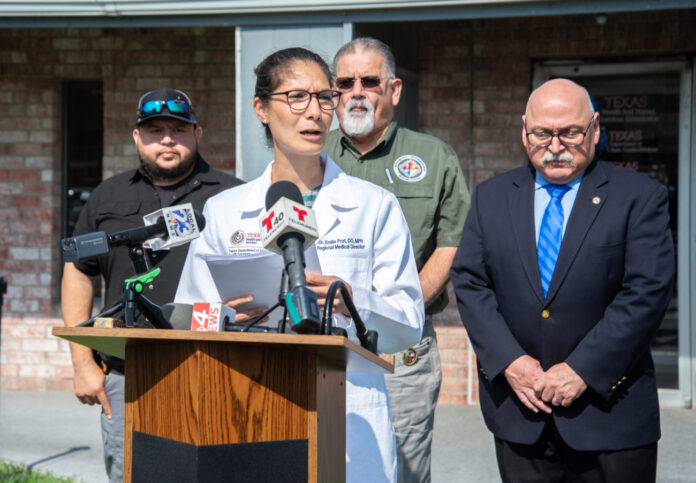Local hospital systems may not be overwhelmed with COVID-19 patients, but that doesn’t mean heightened vigilance and continued social distancing are no longer necessary as Texas on Friday began the slow process of reopening, state health officials said.
“Right now, they’re not overwhelmed, so that is a good thing,” said Dr. Emilie Prot during a conference call with media Friday morning. Prot is the regional director for the Department of State Health Services’ Region 11, which encompasses Texas’ 19 southernmost counties, including the Rio Grande Valley.
“We’ve been observing the curve, and with the social distancing and the measures taken at the local level with the face mask ordinance orders — all of these have significantly helped,” she said.
Last week, President Donald Trump unveiled his plan to reopen the country — a plan that includes continued social distancing and increased testing, combined with at least 14 days of a declining number of positive cases.
Just one day later, Gov. Greg Abbott issued his plan to begin reopening Texas, starting with state parks, which opened Monday, followed by limited non-essential retail, which began Friday.
Yet, while the Valley’s infection curve has never reached the exponential growth rates seen in hard-hit areas such as New York, the number of people testing positive here for the novel coronavirus continues to rise, even as retailers got their first chance to restart modified business operations Friday.
As of Friday morning, Texas had 21,944 cases and 561 fatalities, said Dr. Elizabeth Cuevas, a DSHS health emergency preparedness and response manager. In the Valley, 73 were hospitalized, and six people were admitted to intensive care over the last 24 hours, Cuevas said.
And while Prot wouldn’t go as far as saying Texas’ soft reopening measures were premature in light of the continued case increases, she did emphasize the need for residents, employers and employees to continue social distancing measures — maintaining 6 feet of distance, and refraining from nonessential social calls.
“And going out on a lunch break with coworkers, or going and gathering with family from different households on the weekends — so, all of those things we’re still not there yet,” Prot said.
“We can’t change the virus’ transmission or the way it’s contagious, but we can change human behavior,” she added a moment later.
The goal is to keep the rate of infection to around 10% of the total population nationally, Prot said, that way healthcare systems won’t reach the point where they’re overwhelmed. “It’s not gonna be a reopening from one day to the next. That is not encouraged from public health,” Prot said.
However, more extensive monitoring of the virus is needed to track its spread. Doing that requires increasing an already stretched capacity for testing. “There’s gonna be more and more cases throughout the nation and some of the larger laboratories are gonna become overwhelmed, as well,” Prot said.
State and local officials are looking into ways to bolster that capacity, as well as contact tracing.
In the meantime, as with reopening the economy, easing social distancing restrictions will also need to happen slowly — especially for those at higher risk of experiencing complications from the disease, such as people with diabetes, high blood pressure or obesity.
With a significant number of Valley residents diagnosed with such underlying conditions, the return to “normal” will take longer. “If you’re a vulnerable population — so either elderly or multiple comorbidities … those persons cannot go back to complete normal for a while,” Prot said.




